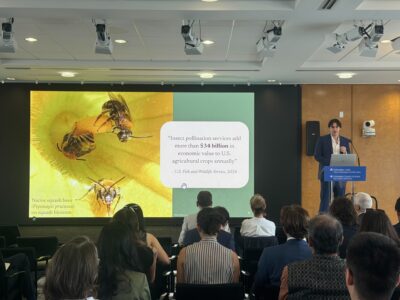
On Monday, June 25, the students in the Master of Public Administration in Environmental Science and Policy (MPA-ESP) program took a field trip to Columbia’s Lamont-Doherty Earth Observatory in Palisades, NY. The trip was organized and led by Lamont Associate Research Professors Jason Smerdon and Juerg Matter, who teach Climatology and Environmental Chemistry respectively during the program’s summer semester.
The day kicked off with a viewing of the video, “Lamont-Doherty Earth Observatory: World Leader in Earth and Environmental Research Education,” to give the students a better idea of what kind of work happens at the Observatory. In addition, students were able to see examples of the research projects at Lamont and interact with some of the observatory’s research scientists. The presentations included “Climate Sensitivity” by Assistant Research Professor Michael Previdi; “Marine Mammals and Anthropogenic Sound” by Associate Professor Maya Tolstoy; “Measuring the Deepwater Horizon Oil Leak Using Optical Plume Velocimetry: Science in the Media Spotlight” by Assistant Research Professor Timothy Crone; and “Ocean Acidification” by Postdoctoral Research Scientist Beth Stauffer.
Students especially enjoyed hearing the underwater audio recordings of whales and earthquakes that were included in Dr. Tolstoy’s presentation and the policy implications of Dr. Crone’s involvement in measuring the oil flow out of the well head after the Deepwater Horizon oil leak in April of 2010.
“Lamont has a long history of scientific exploration that I had no idea about. I’m really glad we are able to spend a day here to learn more about the work being done here,” said Alana Miller, an ESP student.

Through these lectures, students were able to gain valuable insight into the important role that Lamont and the Earth Institute play as research and educational institutions. “It was exciting to see the real world implications of what our professors have been teaching us in class over the last few weeks,” stated Monica Pham, a current ESP student.
Later in the day, Professor Juerg Matter took the students to visit Lamont’s test well site. The students also toured the Lamont estate house and grounds with Professor Jason Smerdon, where they learned about the early days of scientific research at Lamont and the many breakthroughs in understanding Earth systems that have happened on its campus. Lastly, Curator Nichole Anest brought the students to the observatory’s core repository which is home to the largest collection of deep-sea cores in the world – a collection which was helped Lamont’s scientists to better understand the paleoclimate of the earth.
“The Lamont-Doherty Earth Observatory field trip is a great way for the MPA-ESP students to get away from the Morningside campus and enjoy a day outside of the city,” said Professor Matter. “The goal of the day-long excursion to the Lamont-Doherty Earth Observatory was to give the students a taste of scientific information about environmental issues that are relevant for future policy makers.”

Students in the MPA in Environmental Science and Policy (MPA-ESP) program enroll in a year-long, 54-credit program offered at Columbia University’s School of International and Public Affairs (SIPA), in partnership with the Earth Institute. Throughout this one year program, students are immersed in courses that combine Columbia University’s hands-on approach to teaching public policy and administration with pioneering thinking about the environment. During the summer semester, students learn the fundamentals of environmental science, while the fall and spring semesters focus on teaching the policy and economics necessary to becoming successful environmental analysts and managers. Please visit our website to learn more about the program.



